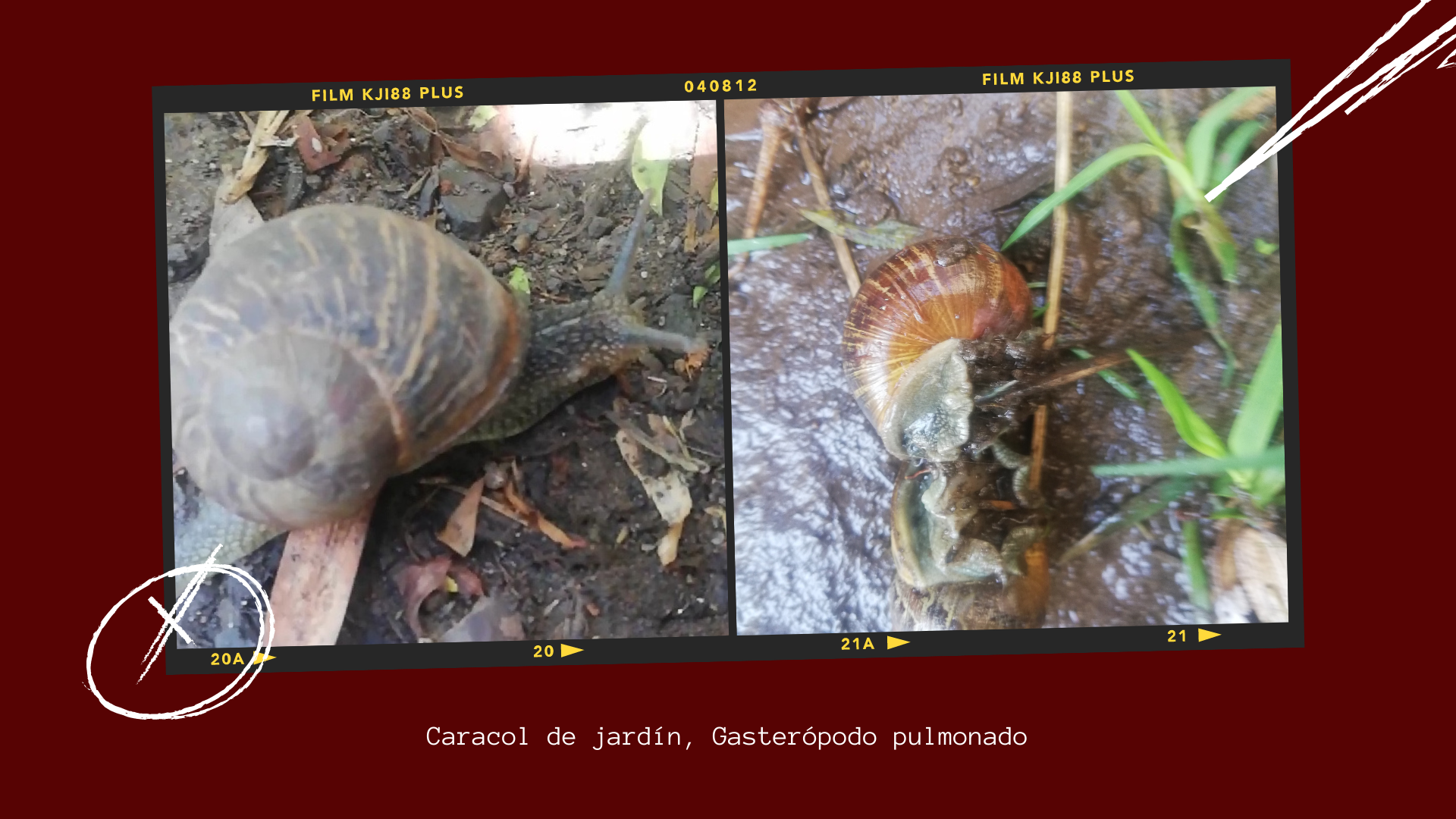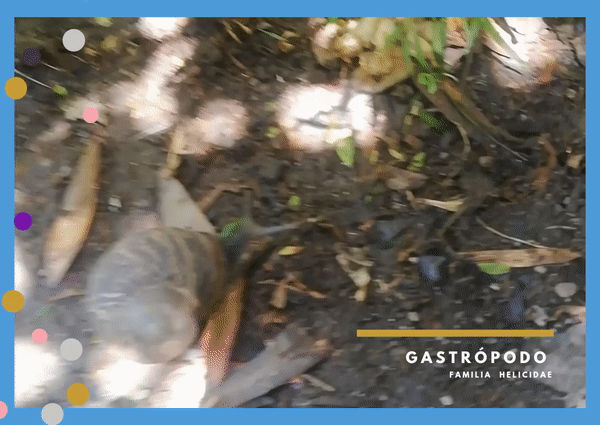A lo lejos se observaba como una masa desfigurada, sin forma, y no tenía movimiento, por curiosidad me acerqué para ver de cerca e indagar sobre lo que se trataba. Mi sorpresa fue darme cuenta que eran dos caracoles que estaban unidos, tal vez es un proceso de reproducción.

In the distance I could see a disfigured mass, with no shape, and no movement, out of curiosity I approached to take a closer look and find out what it was. My surprise was to realize that they were two snails that were united, perhaps it is a reproduction process.

Al inicio de este Boletín, pensé que había cometido un grave error en el texto de las imágenes, pues aparece escrito Gastrópodo y en otros textos se presenta como Gasterópodo, así que debí escribir univalvo o caracol, tal vez molusco, cualquier término que sea más familiar para los lectores. Sin embargo, los caracoles pertenecen a la Clase Gastrópoda y son válidos los otros 2 términos según la definición aportada por la Real Academia Española.

At the beginning of this Newsletter, I thought that I had made a serious mistake in the text of the images, because it appears written Gastropoda and in other texts it is presented as Gastropod, so I had to write univalve or snail, perhaps mollusk, whichever term is more familiar to readers. However, snails belong to the Gastropoda Class and the other 2 terms are valid according to the definition provided by the Royal Spanish Academy.

En fin, la finalidad de este Boletín es presentar un momento particular de la unión de 2 caracoles mientras copulaban, período que dura entre 4 y 8 horas continuas mientras que permanecen unidos con 1 o 2 de sus miembros reproductores en cada uno de los individuos. Recordemos que esta especie de molusco son hermafroditas, así que tienen un tiempo previo a la unión como para ir definiendo el rol de cada uno de ellos, pero en ocasiones prestan su miembro varonil para fecundar a la hembra y a la vez reciben los espermatóforos en la cavidad reproductiva de su parte femenina- ¡Todo un enredo emocional, pero cada especie con sus cosas maritales!
In short, the purpose of this Bulletin is to present a particular moment of the union of 2 snails while copulating, a period that lasts between 4 and 8 continuous hours while they remain united with 1 or 2 of their reproductive members in each of the individuals. Let us remember that this species of mollusk are hermaphrodites, so they have a time prior to the union to define the role of each of them, but sometimes they lend their male member to fertilize the female already at the same time they receive the spermatophores in the reproductive cavity of their female part- Quite an emotional mess, but each species with its marital things!

Luego de 4 días volví a ver la misma escena, la unión de 2 caracoles entre la grama y en la base de un pequeño arbusto que les protegía de los rayos del Sol. Por lo general, el clima tropical y la humedad relativa alta (>70%) crean el ambiente propicio para llamar al encuentro amoroso para la reproducción de estos caracoles de jardín, puesto que pueden colocar más de un centenar de huevos entre la maleza, hierba o debajo de la tierra hasta que eclosionan en aproximadamente 1 semana. ¿Qué comen las crías?, en su mayoría son herbívoros y obtendrán su alimento de sus alrededores, mientras que otras especies de caracoles (acuáticos) pueden resultar ser carnívoros y devorar a miembros de su misma clase.

After 4 days I saw again the same scene, the union of 2 snails between the grass and at the base of a small bush that protected them from the sun rays. Generally, the tropical climate and high relative humidity (>70%) create the right environment to call for a love match for the reproduction of these garden snails, as they can lay more than a hundred eggs among the weeds, grass or under the ground until they hatch in about 1 week. What do the young eat, they are mostly herbivores and will get their food from their surroundings, while other species of (aquatic) snails may turn out to be carnivores and devour members of their own kind.

Cuando el bebé caracol va creciendo, también va aumentando la capacidad volumétrica del caparazón agregando espirales a su concha protectora y su masa corporal se incrementará proporcionalmente a la ración de alimentos que consuma. ¿Cuándo estará listo el caracol para reproducirse?, pues él mismo creará un borde en la estructura de su caparazón que cerrará el ciclo de crecimiento y a partir de ese momento entrará en la etapa de reproducción.
As the baby snail grows, it will also increase the volumetric capacity of its shell by adding spirals to its protective shell and its body mass will increase proportionally to the food ration it consumes. When will the snail be ready to reproduce, because it will create an edge in the structure of its shell that will close the growth cycle and from that moment on it will enter the reproductive stage.
Las fotografías y gif que son presentados en este Boletín son 100% originales y los libero de derechos de autor, por lo que pueden ser utilizados en la comunidad STEM-Espanol y la plataforma Hive.

¿Cómo se reproducen los caracoles?
Caracol

Puedes buscar más información en los siguientes enlaces:
You can also look for more information in the following links:
Caracol
Thanks for your contribution to the STEMsocial community. Feel free to join us on discord to get to know the rest of us!
Please consider delegating to the @stemsocial account (85% of the curation rewards are returned).
You may also include @stemsocial as a beneficiary of the rewards of this post to get a stronger support.
Is this your first snail porn video? lol
An interesting depiction of life at a very basic level. Who knew how snails mated?
Thanks for sharing this interesting post with us.
Cheers!